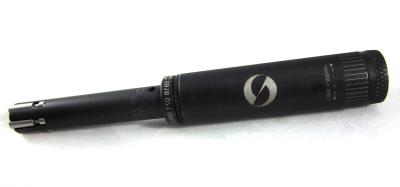
Swiss ID burnishing tools by Elliott Tool Technologies are ideal for accurate sizing, low microfinishing and surface hardening of ID holes down to 4 mm. With the tool body completely inside the tool block, the new 5918 series features an adjustment knob which protrudes from the rear of the tool shank, thus allowing the burnishing tool size to be adjusted for diameter without removal from the tool block. This cost-effective, easy-to-use tooling from Monaghan Tooling Group improves surface irregularities and tool marks, producing optimal surface finishes of 4 to 8 Ra in a single pass. This proven technique can eliminate secondary processes such as grinding, honing and polishing by automating those processes in the primary CNC machine. Doing so saves setup and processing time and labor costs and also enhances machinery utilization and shop floor productivity.
Compact burnishing tools are ideal for applications where the machine working envelope is limited, as is found in most Swiss-type turning centers, small CNC turning centers and when burnishing parts in subspindles where the machine working envelope is reduced.
Burnishing is an ideal way to accurately hold diameter tolerances in “tenths” (0.0001”) and produce microfinishes in the range of 2 to 8 Ra in most steels, stainless steel, aluminum and other metals that have a hardness of under 50 RHC. The new line of compact ID burnishing tools can be applied to a range of industries, such as medical, fuel systems, fluid power and small automotive components.
Economical, long-lasting and replaceable wear parts reduce the total cost over the life of the tool. Wear parts are easy to replace, with common tooling available from stock. Their operation and maintenance requires minimal training.
Contact Details
Related Glossary Terms
- burnishing
burnishing
Finishing method by means of compressing or cold-working the workpiece surface with carbide rollers called burnishing rolls or burnishers.
- centers
centers
Cone-shaped pins that support a workpiece by one or two ends during machining. The centers fit into holes drilled in the workpiece ends. Centers that turn with the workpiece are called “live” centers; those that do not are called “dead” centers.
- computer numerical control ( CNC)
computer numerical control ( CNC)
Microprocessor-based controller dedicated to a machine tool that permits the creation or modification of parts. Programmed numerical control activates the machine’s servos and spindle drives and controls the various machining operations. See DNC, direct numerical control; NC, numerical control.
- grinding
grinding
Machining operation in which material is removed from the workpiece by a powered abrasive wheel, stone, belt, paste, sheet, compound, slurry, etc. Takes various forms: surface grinding (creates flat and/or squared surfaces); cylindrical grinding (for external cylindrical and tapered shapes, fillets, undercuts, etc.); centerless grinding; chamfering; thread and form grinding; tool and cutter grinding; offhand grinding; lapping and polishing (grinding with extremely fine grits to create ultrasmooth surfaces); honing; and disc grinding.
- hardening
hardening
Process of increasing the surface hardness of a part. It is accomplished by heating a piece of steel to a temperature within or above its critical range and then cooling (or quenching) it rapidly. In any heat-treatment operation, the rate of heating is important. Heat flows from the exterior to the interior of steel at a definite rate. If the steel is heated too quickly, the outside becomes hotter than the inside and the desired uniform structure cannot be obtained. If a piece is irregular in shape, a slow heating rate is essential to prevent warping and cracking. The heavier the section, the longer the heating time must be to achieve uniform results. Even after the correct temperature has been reached, the piece should be held at the temperature for a sufficient period of time to permit its thickest section to attain a uniform temperature. See workhardening.
- hardness
hardness
Hardness is a measure of the resistance of a material to surface indentation or abrasion. There is no absolute scale for hardness. In order to express hardness quantitatively, each type of test has its own scale, which defines hardness. Indentation hardness obtained through static methods is measured by Brinell, Rockwell, Vickers and Knoop tests. Hardness without indentation is measured by a dynamic method, known as the Scleroscope test.
- inner diameter ( ID)
inner diameter ( ID)
Dimension that defines the inside diameter of a cavity or hole. See OD, outer diameter.
- polishing
polishing
Abrasive process that improves surface finish and blends contours. Abrasive particles attached to a flexible backing abrade the workpiece.
- shank
shank
Main body of a tool; the portion of a drill or similar end-held tool that fits into a collet, chuck or similar mounting device.
- turning
turning
Workpiece is held in a chuck, mounted on a face plate or secured between centers and rotated while a cutting tool, normally a single-point tool, is fed into it along its periphery or across its end or face. Takes the form of straight turning (cutting along the periphery of the workpiece); taper turning (creating a taper); step turning (turning different-size diameters on the same work); chamfering (beveling an edge or shoulder); facing (cutting on an end); turning threads (usually external but can be internal); roughing (high-volume metal removal); and finishing (final light cuts). Performed on lathes, turning centers, chucking machines, automatic screw machines and similar machines.

